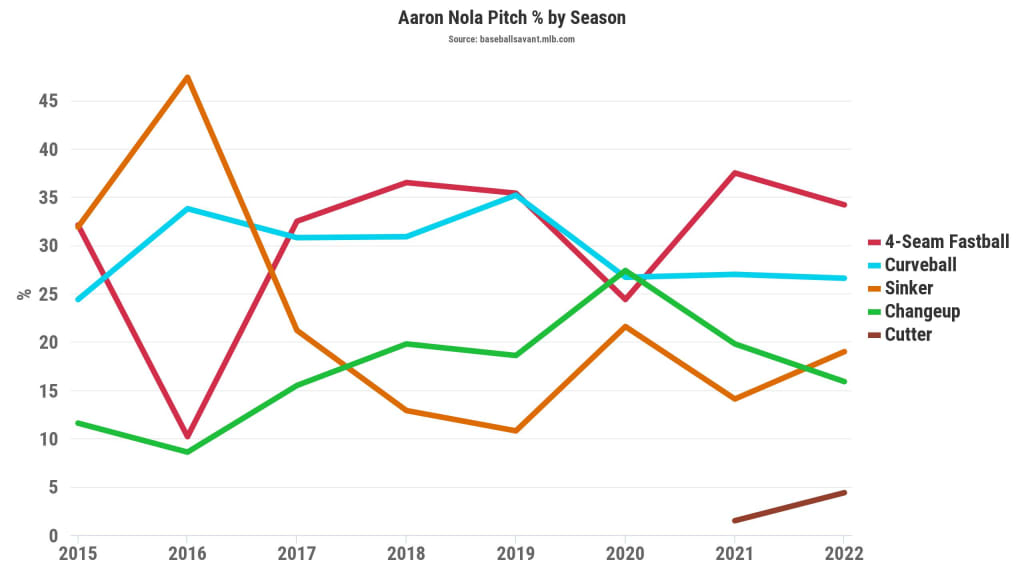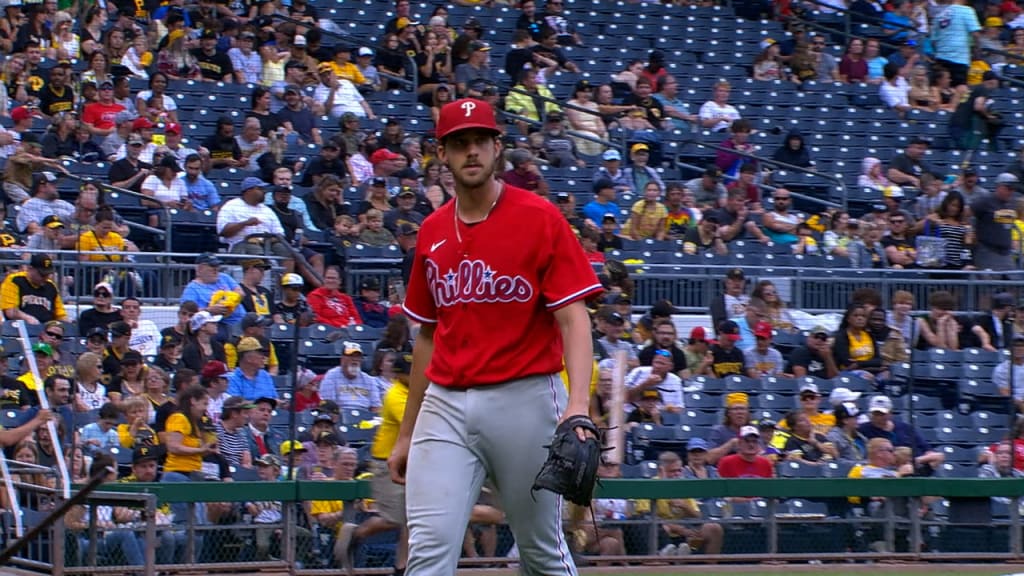Here is how Nola is pitching like an ace again
This browser does not support the video element.
Perhaps the most important factor keeping the Phillies in the thick of the National League Wild Card race amid a roller-coaster season has been Aaron Nola’s return to form.
Despite a lack of consistency over his first seven Major League seasons, Nola offered reasons to believe he could bounce back this year -- none more notable than the gap (1.28) between his actual and expected ERA (3.35) in 2021. Not only has he done just that, but he's re-emerged as one of the game’s top arms.
Entering his start Sunday against the Nationals, Nola boasts a 3.25 ERA and a 2.85 FIP, tied for the sixth best in the sport, and his 3.8 fWAR ranks fifth among qualified pitchers. He is also tied for second in innings pitched (138 2/3).
Can Nola continue to deliver? Sticking to what has gotten him this far will be key.
Increased sinker usage
Over his first two Major League seasons, Nola threw his sinker 41.4% of the time, 11.2% more than his second-most-used pitch -- his curveball -- and 22.8% more than his four-seam fastball. But beginning with the 2017 campaign, he became much more reliant on his four-seamer. And that ultimately culminated in him throwing the pitch a career-high 37.5% of the time last year, when the usage gap between it and his sinker was about as large as it has ever been (23.4%).

As it turned out, that change in approach resulted in Nola -- who entered 2021 with a career ground-ball rate of 50.1% -- posting a career-low 40.8% ground-ball rate. He also gave up 1.3 home runs per nine innings (26 total), his highest mark since his rookie season.
To combat that, Nola has used his sinker almost 5% more this year. And along the way, it’s emerged as one of baseball’s best.
So far this season, opponents are hitting .187 with a .318 slugging percentage and a .245 wOBA against Nola’s sinker. Accordingly, that’s one of his two highly valuable pitches: According to Statcast’s run values, Nola’s sinker (minus-8) is tied for the eighth most valuable in the sport.
What’s made the pitch so effective? Well, he’s not throwing it any harder, at 92.1 mph. Nor is he avoiding hard contact significantly better or getting more swings and misses with it -- his 11.8% swing-and-miss rate with the pitch is actually one of the game’s weakest. Instead, he’s throwing it in the zone more than he ever has (62.8%), and he’s getting more called strikes.
On the year, Nola has received a called strike on 47.9% of the sinkers he’s thrown that weren’t swung at, which is not only a career best but 8.1 percentage points better than last season. That is, among all the pitchers with 200 takes on sinkers, the fourth-best mark.
When hitters do make contact with the pitch (hits, outs, errors), the outcomes are mostly good, certainly better than last season. And when contact isn’t made (balls, called strikes, swinging strikes), the outcomes are great, better than every regular MLB starter outside of Wheeler.
A more effective four-seamer
Another reason why Nola’s sinker has been so good is because of how it plays off his four-seamer -- which has roughly 13 inches of horizontal movement, nearly five inches more than four-seamers at the same velocity. In the same vein, because of that increased sinker usage, his four-seamer has also become more effective.
This is where Nola’s other highly valuable pitch comes in: his four-seamer is tied for the ninth most valuable this season, with a minus-11 run value. Between it and his sinker, he’s one of only six pitchers who possess two offerings with a run value of minus-8 or better, the others being Sandy Alcantara, Tony Gonsolin, José Quintana, Justin Verlander and teammate Zack Wheeler.
In throwing his sinker more and his four-seamer less -- its usage is down 3.3% from last year -- Nola has kept hitters on their toes. The result: He ranks first in opponents' batting average (.164), second in wOBA allowed (.228) and fourth in opponents' slugging percentage (.295) among MLB pitchers who have thrown 500 four-seamers this year. His hard-hit rate on the pitch is also down 11.4%.
This browser does not support the video element.
He’s keeping runners off the bases
Nola’s command has always been his calling card, going all the way back to his days at LSU. But after posting a 6.7% walk rate in his first four Major League seasons, he saw that number jump to 9% from 2019-20, the sixth-highest rate among qualified pitchers in that span.
Despite the frustrations of last season, it marked a return to normalcy for Nola in that regard, as he recorded a career-best 5.2% walk rate. This year, he’s been even better, with the lowest walk rate among qualified pitchers (3.3%).
Combine that with his 28.2% strikeout rate, and Nola not only has the highest strikeout-to-walk ratio (8.44) of any qualified pitcher this year but is on track for the best mark in Phillies history. Cliff Lee holds the current record of 7.39, set in 2012. Nola’s strikeout-to-walk ratio also ranks as the ninth best in the modern era (since 1901).
Nola’s ability to rack up strikeouts and limit walks has, in turn, made him one of baseball’s best at suppressing baserunners. His 0.94 WHIP is the fifth lowest among qualified pitchers. It’s also currently the second best in franchise history, behind only Hall of Famer Pete Alexander -- who logged a 0.84 WHIP in 1915.
He’s making fewer ill-timed mistakes
Although he wasn’t nearly as proficient as he’s been this season, Nola pitched fine without runners on base in 2021. But with runners on, he got hit hard. His .342 wOBA allowed in such situations was the second worst of his career, while his .349 wOBA allowed with two outs and runners on was the worst of his career.
This year, Nola has bounced back to lower his wOBA allowed with runners on base by 36 points. He’s also cut his wOBA allowed with two outs and runners on base in half, all the way down to .174, tied for the best mark of his career. That’s played a key role in him raising his left-on-base percentage by a hefty 7.1 points, from an MLB-worst 66.8% last season to 73.9% this year. He has improved similarly with two strikes.
After surrendering an NL-leading 82 two-strike hits -- including 10 homers that followed 0-2 counts -- Nola entered 2022 with a primary focus of making fewer mistakes with two strikes. So far, he’s given up 46 two-strike hits, the fifth most in the NL. Only 21, though, have gone for extra bases (15 doubles and six homers). He’s also allowed only one homer after getting ahead 0-2, as his strikeout rate in such situations has risen from 47.6% to 51.7% and opponents’ batting averages have dropped from .195 to .128.
Can he keep it going?
As much as the underlying numbers favored Nola in 2021, they support him just as much, if not more, this year. To start with, he isn’t allowing a ton of hard contact, with a 32.5% hard-hit rate allowed, ninth lowest among all pitchers to allow at least 250 batted balls. His 2.75 expected ERA is also the third lowest of that same group -- and 49 points better than his actual ERA.
Two more months of this sort of production, and Nola might all but ensure the Phillies are still playing in October. If he does, perhaps it will be him -- not Wheeler -- who toes the rubber for the franchise’s first playoff game in 11 years.
